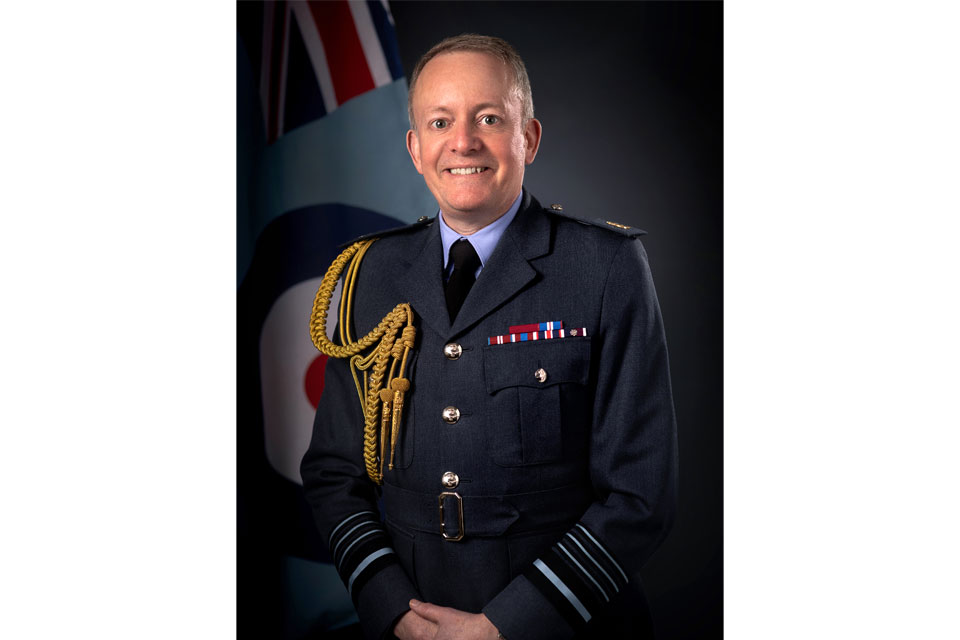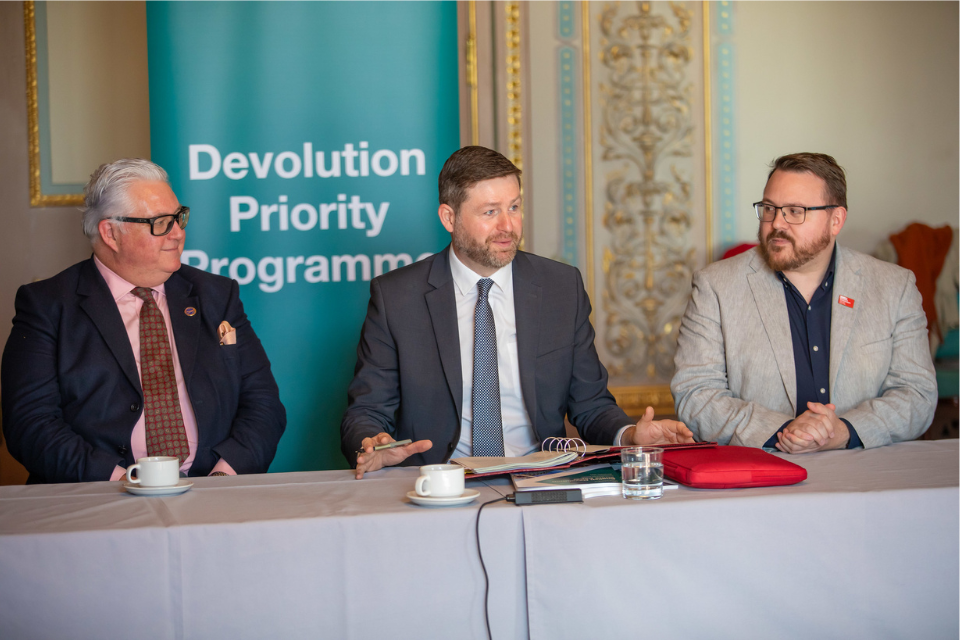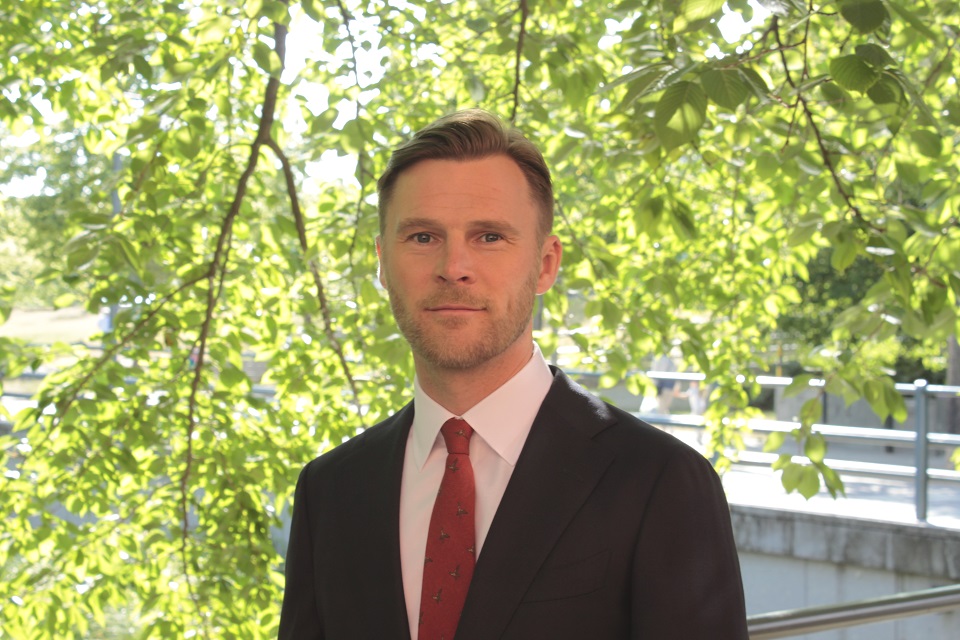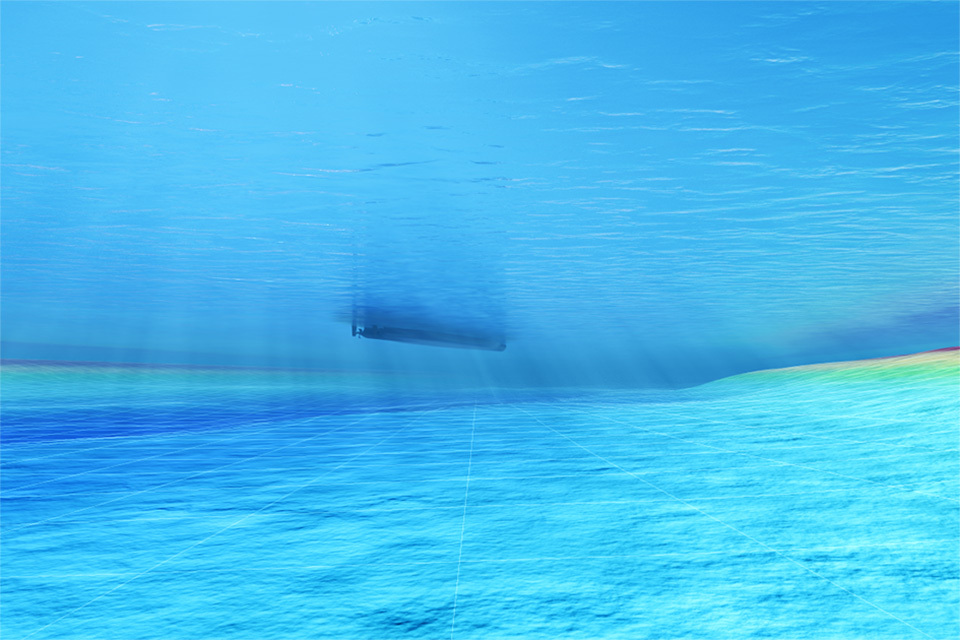Susannah thank you very much and Dave thank you A – for being here and B – for giving such a great presentation, I am now starting to doubt the fact that I took out the animal videos from last year out of my presentation.
As you heard yesterday this is the last appearance for me as the CAS at the Global Air Space Chiefs Conference and I am going to miss it. This conference provides a fantastic opportunity for us to get to know each other, build relationships, and most importantly to share ideas.
Combined with RIAT and the invitation to our crews, to our industries, and to our spouses, this always feels like a very special event.
You might remember that two years ago I showed this picture of Caitlin and me on holiday in Greece as a mechanism to try and build a rapport or relationship. I got in trouble because I hadn’t cleared it with her before I showed it but I’m doing it again, it’ll be fine.
I wanted to start today by saying a huge thank you to the global air and space chief community for your friendship and support over the two years while I’ve been chief and particularly over the last year.
Some of you know that Caitlin was not at RIAT last year as she underwent a pretty aggressive form of chemotherapy, and that camaraderie and support that I felt from this international community was incredible. It’s those bonds of friendship and understanding that will sustain us both in peacetime and in war.
I am pleased to say that Caitlin is doing well and she’ll be back at RIAT.
And for those of you who are wondering she is still a divorce lawyer. So, if she hands you her business card you should be afraid, if she hands your spouse her business card – be very very afraid!
Two years ago in 2023 when I stood on this stage, the war in Ukraine was just over a year old and my key conclusion was that after 3 decades of peace dividend and fighting impressive counter-terrorism campaigns globally, we – the Royal Air Force and other air forces needed to change if we were going to avoid the kind of war that we saw playing out in Ukraine.
Our response to this demand for change intellectually was to update our air operating concept. At the heart of it is this idea of decision superiority supported by agility, integration, and resilience.
Roll forward a year, last year we focused on deterrence. In whatever way you describe it, warfare is costly, and I argued that our job as military leaders was to stop these wars from starting.
I also explained last year where our priorities lay in terms of developing the capabilities to ensure we could deter the kind of fight we’ve seen in Ukraine.
It started with command and control. Capabilities to counter the A2 AD threat. Integrated area missile and defence and agile combat employment. And taking a leaf out of Dave’s book I also showed you this picture of my good friend Patrick Sanders, shortly after he finished being the head of the British Army at Glastonbury. I’m pleased to say that Patrick has gone past his Glasto phase and is now a successful podcaster and it’s really good, I can really recommend it. But Patrick was in the news again last weekend with a warning that we should head as we think about the pace of change.
As you heard from the Minister, last month the UK published its Strategic Defence Review, a vision about making Britain safer, secure at home, and strong abroad. It played back to us much of the logic and analysis we’ve talked about in conferences like this for several years. As you’ve heard today, it focuses on warfighting readiness, it’s clear about putting NATO first, and using defence as and engine for growth, with UK innovation driven by lessons from Ukraine, and a whole of society response.
This is a radical shift for the UK.
And all of that is before The Hague Summit where many of our allies signed up to spend significantly more on Defence.
This is a watershed moment for the UK and the West.
Throughout my whole career Defence budgets have shrunk, armed forces have got smaller. I was at RAF Cranwell recently talking to our officer cadets about to graduate and coming out into their next phase of training and into the Air Force. I told them that they are entering an air force that none of us have known. An Air Force where budgets are growing, and numbers are increasing.
Last year, I also talked about the high low mix and its importance and autonomous collaborative platforms, and you’ve heard about that from the minister this morning.
I got Jim Beck our Director of Capability, who we saw yesterday, to promise in front of all of you he would deliver this year the first of a family of ACPs that would improve the lethality and survivability of our crewed platforms.
I want to pay tribute to Jim today and the wider team for delivering in April this year StormShroud.
It is an impressive capability that was delivered with a different attitude towards risk both in terms of its acquisition and in the terms of the way it’s operated. It also delivered through collaboration with warfighters, traditional defence industry, and new entrants to it.
I am enormously proud of what Jim, the team and the wider team have done to deliver it, and I am enormously pleased that what SDR sets out is a direction of travel that we have been on as air forces for several years.
But the SDR is clear, and I’m clear that we have to do this quickly, and we can’t do it on our own.
To borrow a phrase from my great friend Jabba Steur the Dutch chief, we need to be ready to fight tonight, tomorrow, and together.
These alliances, that these conferences help build are incredibly important to us, and frankly the alliance with the United States of America is the most important of all.
Arthur Tedder and Tooey Spatz, the first Chief of Staff for the US Air Force, forged a relationship during the second world war that sustained them through peace. Today the relationships we form in peacetime need to sustain us through war.
This year has seen many of us in this room flying alongside our US friends and fighting alongside them globally.
But is not just about working together as allies, this evolving battlespace demands that we work together across all 5 domains, and that’s why that is the theme of this conference how do we integrate air and space power into this evolving battlespace.
I want to use 3 stories from the past, present and future to illustrate why this is important and what lessons we might draw about how we do it.
Now looking round the room, I think quite a lot of us in the room remember the early days in our career the end of the Cold War.
Every self-respecting junior officer would have read Tom Clancy’s Red Storm Rising.
In it, NATO face the task of repelling Russian aggression from Eastern Europe through or by, as Tom said,
‘…penetrating the most concentrated SAM belt the world had ever known.’
In Tom Clancy’s day that was a job for Air Forces it required large packages of aircraft, it was what our flag exercises, Red Flag, Green Flag, Maple Flag, were all about. Honing our Large Force Employment skills – we relished the opportunity; we loved flying and fighting alongside the very best from other nations.
I’m sure just the mention of it evokes warm memories at the time when it was the air force that we knew and loved, when we had more hair, slimmer waists, and we didn’t groan when we got out of chairs.
This was air power’s World Cup. I was also going to say this was, for our American audience, it’s like the World Series, but I found out that Donald Trump seems to recognise Soccer is the more important game, and if you’re going to have a world event you do have to invite people from other countries to it, just saying. Sorry Dave!
This was a complex mission and attrition was expected. In Tom Clancy’s novel, more than a dozen of the most technologically advanced aircraft the West had were lost on that first mission. In the 1980s we had the mass to cope with that kind of level of attrition. Today, we know that this is going to require more than just brilliant air forces. Even the most ardent advocate of air power, Dave Deptula agrees.
In Tom Clancy’s time, other terrestrial domains lacked the tools to be able to really influence this fight. Space and cyber weren’t even nascent capabilities.
Today, not only is it feasible to integrate effects across multi domains, it is essential. And this is hard, it’s hard to do it on a national level, trying to do it multi-nationally, across a continent is exponentially more difficult but it is the challenge of our generation, and our adversaries know that and they’re trying to emulate us. Fortunately, however they are showing us how not to do it.
When Russia invaded Ukraine in 2022, it looked like integrated multi-domain operations. With two combined armies, supported by strategic fires, tactical and strategic air power provided by VKS, land launched, sea launched, air launched cruise missile, electronic warfare, and critical space and cyber effects, surely that was integrated?
But the reality is Russia’s sees air power differently to the west, in the western way of warfare, air power is at the heart of the way we fight. In Russia it’s about supporting the land campaign, and we know as Justin Bronkin and Dag Henrikson have pointed out that Russia has always struggled to integrate air power emissions to deliver strategic effect. So in those first few hours and days after the war started, what we saw was Russia’s actions were stove pipped, they were deconflicted in time and space and fratricide both electronically and kinetically was commonplace. But three years and a million causalities later, Russia is learning. And we have to learn too, as General Patton said,
Our job as air chiefs is to educate our aviators and our commander so that we are ready for the next Storm Rising. There’s no way I could write it.
I’ve stood on this stage and said, that we should not image that Ukraine is the way in which we would fight in the future. Ukraine is a 19th Century war, fought with 20th Century tactics and 21st Century weapons.
What we need to do is fight 21st Century war, with 21st Century capabilities, and 21st Century thinking.
2025 has given for us some examples of how this air led innovation and integration can make a difference. We’ve heard about Ukraine’s audacious attack against Russia’s strategic assets and operations in Iran have really shown us what exquisite air power integrated with other multi-domain effects can do at both the strategic and campaign level.
But when the war starts, we know that it’s going to be a dynamic environment, and so whilst the tactics and the targets might be the same as they were in Tom Clancy’s day, the threat has changed, and the tactics need to change too.
There’s breadth, scale, depth coupled with three years of operational experience mean the threat is much greater than it was in Tom Clancy’s time. And so the tactics need to change, and we need an integrated approach.
We need space, cyber, land, sea, and air to work together.
We know space will deliver PNT, we know it will deliver ISR, we know it will deliver battle damage assessment, but it can also be used to disrupt our adversaries’ communications. We can shield our own forces from their satellites.
Cyber can disrupt and degrade C2 systems.
The maritime environment might deliver fires or air defence.
The land domain might launch Stromshroud, project special forces or launch attacks against key targets.
We get this right; we create control of the air. We might be limited in time and geography, but it opens up the opportunity for our forces to target and exploit other opportunities.
But no plan survives contact with the enemy and we need a mechanism to adapt and react, to ensure that we’re able to exploit opportunities and make the right decisions at the right time in this complex environment.
In the UK we’ve developed NEXUS, it’s our combat cloud and it will form part of the digital targeting web the minister talked about this morning and it’s through that that we’ll deliver the tempo and deliver that all domain C2. But C2 is about more than the network, it’s about our commanders, our decision making and our training. We’ve got challenge in NATO in particular, how do we command and control in a dynamic environment, multi-domain operations when we’re structured by component and organised by components or geography.
NATO’s land component commander argues that it’s the Army’s task, the Army should, alone deal with the counter A2 AD threat in Kaliningrad. He might be right in that specific environment, but it’s not proven or tested. It would be like me saying that actually it’s air power that should be the soul force that blunts Russian attacks into NATO territory. We need to lift ourselves out of these historic rivalries and reductive arguments and think about how we deliver truly integrated multi-domain effects.
How do we set the board at risk in the way Dave said yesterday to make sure we are ready for the next Storm Rising.
We can learn lessons from other campaigns and operations and the next panel will talk about some of those. But I think we need to test, to train, and to educate our people.
In the real world, exercises like Bamboo Eagle provide high-end, multi-domain, multinational and long-range exercises where we can test ourselves against these kinds of scenarios. Red Flag has always been the pinnacle air exercise, in this case Red Flag was just the starter to the main course which was exercise Bamboo Eagle.
175 aircraft from Canada, the UK, Australia, and the US. In an operation that ranged right across the indo-pacific. But we don’t just need to rely on the real world anymore, the synthetic environment provides us with opportunities to test and train in ways we’ve not been able to before.
In the UK, we’ve developed Gladiator, a synthetic, multi-domain environment that connects national and international components so they can mission rehearse the most complex of multi-domain operations that we are unable to imagine.
Earlier last year, in Exercise Cobra Warrior, the weather meant that we were unable to conduct some of the flying that we intended, quite a common thing in the UK.
What we did was, we flew the mission in Gladiator. The full COMAO flew real-time, and then the combined synthetic and real picture that came from that was fed into the was fed into the ops centre which allowed our C2 and ISR teams to test themselves as though it had been for real.
We can no longer wait to find out what we know and adapt when the war starts.
For those, like Dave and Shawn Harris who have walked the corridors of the USAF’s School of Advanced Air and Space Power Studies, they’ll see this quote.
We need to provide those opportunities for our people, so that they are ready for the next Storm Rising.
The Americans have shown the way with Bamboo Eagle and the phenomenal capability off the coast of California, but I think we need something like this in Europe too.
Somewhere where we can bring our Armies, Navies, and Air Forces together. Where we can test the land component commander’s assertion that he can alone address the counter A2 AD task in Kaliningrad. Where we can find out how do we command and control multi-domain effects in NATO when we’re organised by components.
We have talked and sat around the NATO Air Chiefs table about creating some airspace we can turn on and off over the North Sea. But for our agencies and our airlines it’s all a bit too difficult.
Now to be fair, North Sea might not be the right place. Our friends in Sweden and Finland have got a lot of space and are keen to help. What I would like to do is to see our European and NATO forces pool our resources and create that capacity and capability here in Europe.
So let me sum up.
We have to be ready for this next Storm Rising.
We know it is going to be harder than it was in Tom Clancy’s day.
Fighting a bespoke, exquisite air campaign that’s not integrated into this evolving battlespace will lead to campaign failure.
What we need is genuinely integrated multi-domain effects, at this operational and strategic level not just at the tactical level where we know that we excel. How we do that is through thinking and practice. We can do some of that in synthetic environment and that also allows us an opportunity to exploit some of those tools that Keith and others talked about yesterday. But we need to do it in the real world too, so we can identify the frictions and fix them.
I’ll be honest, I don’t know the answer to this NATO conundrum about command and control and how we do that command and control integrated action and deliver multi-domain effects when we’re organised by component. But the answer to it starts with thinking and practice, and it’s through that we will be able to deter, to fight and to win – tonight, tomorrow and together.
Thank you very much.








